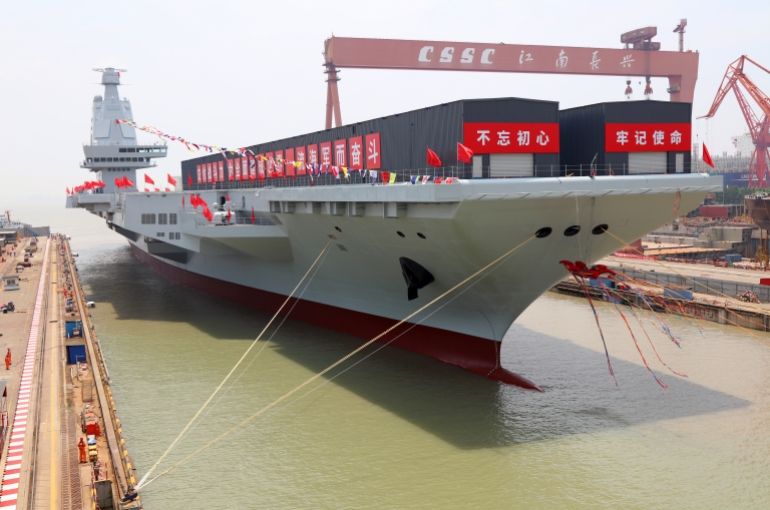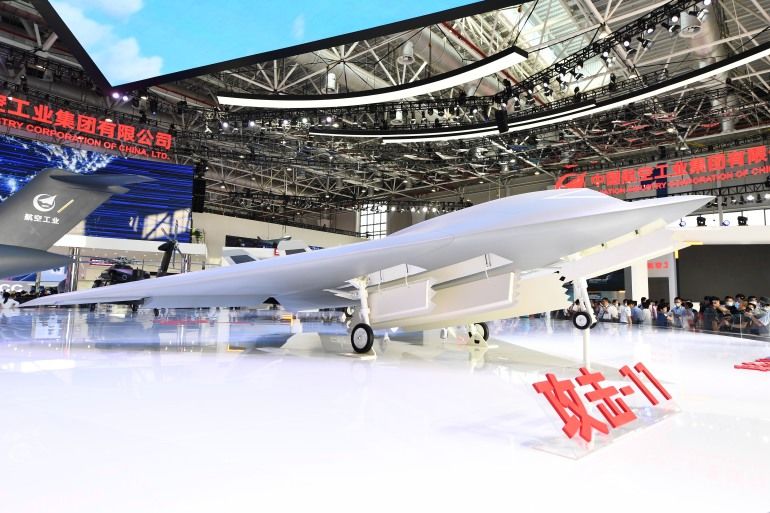With its new aircraft carrier, the Fujian, China is leapfrogging current military technologies to challenge the might of the US navy.
The Chinese navy, under instruction from President Xi Jinping, has undergone a modernisation and expansion programme that is nothing short of spectacular. Friday’s launch of its third and most advanced aircraft carrier, the Fujian, for sea trials underscores just how far it has come, and how fast.
The first two carriers, the Liaoning and Shandong, were ex-Soviet designs; the Liaoning initially bought for scrap from Ukraine and refitted. While antiquated, they have been used to train new generations of naval officers and pilots in the complex science and art of aircraft carrier operations.
This new design of aircraft carrier is a quantum leap in capabilities from these older models and will greatly enhance China’s combat power.
 The launching ceremony of China’s third aircraft carrier, the Fujian, on June 17, 2022, in Shanghai, China
The launching ceremony of China’s third aircraft carrier, the Fujian, on June 17, 2022, in Shanghai, China Larger, more powerful
The Fujian is colossal: at 316m (1,037ft) long, it will weigh around 100,000 tonnes when fully loaded. Its electromagnetic aircraft launch system (EMALS) will accelerate jets taking off at speed, assisting their take-off with such force the aircraft will be able to carry more fuel and weapons, therefore extending the reach and size of the punch the aircraft carrier packs. Early warning aircraft will be able to take off and land more easily, enhancing the carrier’s ability to spot its enemies from further away.
EMALS is also able to launch more aircraft at a greater rate, getting more jets into the air faster than its opponents using older technologies – and is vital for defending itself against incoming attacks.
This latest feature gives the Fujian a significant edge, as only the United States’ latest Ford-class of aircraft carrier is equipped with it. France is slowly developing a similar system and India is examining its feasibility, but outside the US, only China employs this system. Its navy has yet to operate a nuclear-powered carrier, as the US has done for decades. The Fujian is conventionally powered but predictions are that the next one to be built by China will be nuclear-powered.
The Fujian has shown the world that China has leapfrogged over several current military technologies, like steam catapult-launching, rejecting them for cutting-edge designs that will set up China’s carrier fleet for years to come.
Diplomacy by other means
The goal for China’s navy is to have six carrier strike groups operating by 2035, allowing China to project levels of combat power unprecedented in its history wherever it chooses. Aircraft carriers do not operate alone and form the nucleus of a fleet that surrounds the carrier, protecting this mobile airbase while also contributing massive amounts of firepower that can devastate targets on the ocean or hundreds of kilometres inland.
Their large compliments of long-range land-attack missiles, together with the carrier’s air wing, provide state-of-the-art firepower, giving China a potent weapon at its disposal. An aircraft carrier strike group’s prime role is to project power far beyond its national borders. This can be done using actual combat power, or force can be implied, the proximity of an air carrier strike group to a crisis zone acting as a diplomatic barometer. Either way, they have been effective tools of statecraft for decades.
China’s naval expansion isn’t just about the number of warships. The navy’s infrastructure, vital if ships are to be berthed, maintained and refuelled, has slowly been built up over the last decade. A network of port facilities and dry docks have been constructed across the Indian Ocean with a growing naval fleet in mind.
The Chinese naval base at Djibouti has been revamped, its piers extended to 340m (1,115ft) and now able to accommodate its growing fleet of aircraft carriers. Situated at the mouth of the Red Sea near the Horn of Africa, the base is rapidly becoming a logistical supply hub for Chinese naval vessels in one of the world’s most strategically significant waterways. As China’s economy becomes truly global in scale, its naval fleets are fast moving away from protecting China’s shoreline to long-range force projection. This has the US increasingly concerned as China negotiates base rights in Equatorial Guinea on Africa’s west coast with the aim of building a naval presence in the Atlantic Ocean.
But wait, there’s more
Significant as China’s naval ambitions are, this is just the beginning. The Fujian is a transition model, perfecting a powerful new technology, while Chinese naval propulsion specialists and designers are looking to take the next technological leap. Its fourth carrier is now likely to use nuclear propulsion. This will allow it to sail without refuelling or refitting for 20 years. It may however delay the carrier’s construction and eventual induction into the Chinese navy as new technologies, especially nuclear ones, are worked and trialled with great care.
The design process has already started on this future carrier and construction will begin in the near future at Dalian shipyard. It is expected to be at least the same size as the Fujian if not larger. Its expanded air wing will likely fly the latest FC-31 Gyrfalcon naval stealth jets, early warning aircraft and drones.
Unmanned technology presents a significant challenge, but is tantalising as it may give the country that develops it first a significant strategic advantage.
The unmanned navy
While the US works on new robot ships, China is not far behind as it looks to develop and expand its unmanned networked fleet. It has launched the world’s first “drone carrier”, controlled by AI systems. It will be able to deploy underwater, surface and aerial drones, working to ensure that no adversary can approach it without being detected. While it is just a test bed for this new generation of automated naval ship, more advanced “carriers” are being designed as unmanned technologies are integrated into the manned Chinese navy.
An advanced version of the Type 076 Helicopter carrier is being developed with the aim of launching combat drones from its flight deck. While this is a capability being researched by other navies, the Chinese variant will likely carry a naval version of the stealthy combat drone the GJ-11 “Sharp Sword”, which is able to fly at close to the speed of sound, undetected by its enemies.
At over 11m (36ft) long and with a range of 4,000km (2,485 miles), it can carry over two tonnes of precision-guided munitions in its internal weapons bays – and is designed to penetrate deep into hostile territory and destroy high-value targets.
 A Gongji-11 (GJ-11) unmanned stealth combat drone on display at the 13th
China International Aviation and Aerospace Exhibition on September 28,
2021, in Zhuhai, Guangdong Province
A Gongji-11 (GJ-11) unmanned stealth combat drone on display at the 13th
China International Aviation and Aerospace Exhibition on September 28,
2021, in Zhuhai, Guangdong Province
Powerful unmanned mini-destroyers are also being designed, with advanced radars, torpedo tubes and the latest surface-to-air missiles. They are able to pack a powerful punch, especially when networked together, and analysts consider this a rival to the US’s unmanned surface vehicle (USV), the Sea Hunter.
China is competing neck and neck with the US in unmanned weapons systems. There is a fierce debate within Chinese military circles about where to put its significant yet finite resources to the greatest effect. Many argue for funding to go to the large, visible ships like aircraft carriers and cruisers. However, there is a growing voice within the People’s Liberation Army that argues for smaller, smarter, well-armed vessels. While nothing in themselves, when networked together in a coordinated “swarm” fleet of distributed firepower, they become overwhelming. Like an army of ants, several might be destroyed, but acting together, they eventually overpower a much larger force, and China is at the forefront of this vital technology.
This kind of strategic planning is crucial if China is to win the next war fought on the ocean. Future conflicts will not be won with today’s weapons, but with tomorrow’s. The country that invents these new systems and trains realistically on how to use them to their best advantage, will prevail.
With the launch of the Fujian, the naval arms race in the Pacific Ocean has just picked up the pace and shows no sign of slowing down. China’s production of new and advanced warships is growing by the day. This new leviathan now aims to challenge the might of the US navy, not content to be a regional player but a superpower in its own right.















